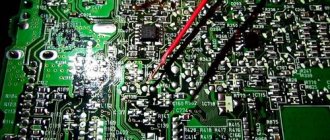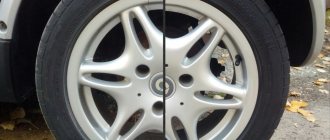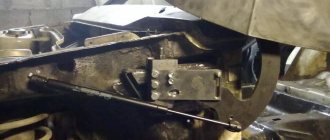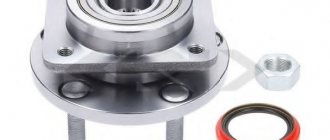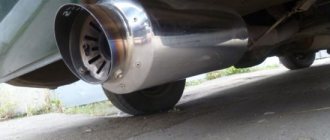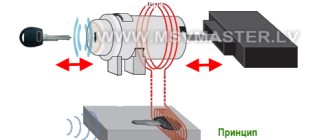Modern music equipment is equipped with a variety of connectors, among which AUX is considered the most universal. This abbreviation translated from English means “secondary”, “additional”. Found on TV sockets, home theaters, CD players and car radios. On past equipment, the connector was labeled CD-IN, but experts call aux in a car radio a “line input.”
AUX socket with connected adapter and flash drive
What is AUX IN and what is it for?
This port is needed to connect external audio sources in order to amplify their sound and receive information recorded on them. The main requirement for connected devices is that the output voltage must be within 0.5-1 Volt. This is exactly the range that most output equipment has. Externally, the aux-in socket is a round hole edged with a thin metal ring. The connector is most often located on the front panel of the car radio; sometimes it can be covered with a special cap that protects the port from dirt and moisture.
What can you connect with it?
Almost any electronic gadget that has an appropriate output. Most often, using a special aux wire, they connect:
- Mobile phone, smartphone with Android or another operating system. You will need a special adapter wire. Then you will be able to listen to music recorded in the phone’s memory through high-quality car audio equipment.
- Computer tablet.
- An audio player (including MP3) that works only with headphones and does not have its own speaker.
- Microphone, if the radio has a karaoke function.
- Laptop.
- Old analog equipment, for example, a cassette recorder.
The presence of an aux connector is standard for any modern audio equipment. Therefore, most manufacturers are required to install this connector.
Telephone with AUX cable, ready to connect
Some technical details
The linear input receives a signal with an amplitude of 0.5 - 1.8 V. This signal magnitude is supported by sound-reproducing devices with a linear output. The socket is marked “AUX OUT” or “CD OUT”. The signal supplied to the headphones has the same magnitude. Therefore, the headphone output of the headphones connects perfectly to the AUX IN input.
The design of all of the above sound-reproducing devices includes a sound amplifier. It is to this that the signal from the linear input is directly supplied. Using this algorithm, the signal generated by the MP3 player and iPod is amplified. The amplified signal is then played back through loudspeakers.
Using this method, you can listen to music collections collected on a player, tablet or phone through the car speakers. We connect the car receiver or radio via “AUX IN” to the playback device.
The connection of digital devices is controlled through the menu; analog devices have a standard switch. Since the initial volume level is difficult to control, it is recommended to set it to the minimum level before connecting.
The presence of an “AUX” connector will give a second wind to outdated analog equipment. For example, a cassette recorder can be connected to a modern music center or player.
Standard Mini Jack 3.5mm Cable
You can purchase such an aux cable for your car radio at any radio store or mobile phone store. The wire must have a round plug with a diameter of 3.5 mm on both sides. It’s rare, but it happens that your gadget’s output (designated as OUT) has a socket of a different type. Then you will have to look for a cable with a 3.5 mm Mini Jack on one end and a mating part on the other that fits the connector on your gadget. The disadvantage of using a wired method of connecting on-board audio equipment and an external device is the presence of a cable that can get in the way in the cabin. But there is a plus: no radio interference interferes with the correct transmission of information, and it is also possible that while listening to files, the phone will be charging at the same time.
All you have to do is choose the desired cable length
Why is it playing quietly?
If the user connects an external device and it plays quietly, it is recommended to check the condition of the patch cable. When metal strands break, the quality of the transmitted signal decreases and is not reproduced correctly by the radio. A test device is used for checking; damaged cables must be replaced. The problem also occurs when the sound volume is incorrectly adjusted.
AUX-USB adapter
This is a regular cable with different plugs at the ends. You can buy it in the same place as Mini Jack. The only thing you need to look at is the USB port. It can be different:
- Type A (USB 3.0, blue inside) - it can be seen on the wires for connecting a computer mouse, keyboard, printer, chargers.
- Type B - previously used to connect printers, but today it is practically not used, giving way to the variety described above.
- Mini USB (USB 2.0) is a smaller connector; it can be seen, for example, on digital cameras and some gadgets.
- Micro USB is a standard connector used in almost all mobile phones.
All you have to do is find out what standard socket your gadget has and buy a wire with the appropriate plug.
Cable with USB adapter and Bluetooth
Bluetooth adapter
This is the best option: when using it, information is transmitted wirelessly, and cables in the cabin do not interfere. To use this method, you will need to purchase an adapter, one side of which is connected to Bluetooth, the other is inserted into the AUX jack with a diameter of 3.5 mm of the on-board multimedia or radio.
Advantages of this connection method:
- excellent codec - the quality of the reproduced sound is quite high;
- quick and easy connection - you just need to press a button, after which the adapter will install everything automatically;
- ease of control - you can control the operation of the adapter via the remote control, voice or buttons on the device panel;
- ability to work with multiple devices.
But there are also negative sides. First of all, this is the relatively high cost of the adapter. Secondly, its autonomy and the need for periodic recharging. But there is a way out of the situation, and it is described below.
Port connection options for listening to music
The cable for connecting to the AUX connector may not be simple: in one case it interferes, in another case the mobile device does not have a 3.5mm jack. In this case, you can choose a cord with a 3.5mm jack at one end and a corresponding connector at the other. There are universal adapters that contain a whole range of different connection options.
Another universal solution is to use a Bluetooth adapter. This method can be used to connect almost any smartphone. This option offers fairly broad functionality. In this case, signal transmission occurs without a cord; control is possible by voice, adapter buttons or from the remote control. In this case, it is convenient to receive calls from your phone, dial the last number, and manage your media library from the adapter. The high quality of the device ensures good sound clarity.
A noticeable disadvantage of using the adapter is that it must be periodically charged, since there is no power at the AUX connector. In practical use, there may be a loss of communication, incorrect operation of buttons and voice control. The service life, especially of inexpensive devices, is limited.
How to make an AUX cable for a car radio with your own hands
To do this, you need to be able to work with a soldering iron and at least have a little understanding of electrical circuits. You will need a pair of non-working headphones for your phone or computer, or rather, wires from them with 3.5 mm mini-jacks.
Next steps:
- Cut the wire where it connects to the headphones.
- Remove the plastic insulation (you can use a soldering iron or a small sharp knife).
- Inside you will see three wires in white, blue and green. Of these, the first is mass, the second is 1 channel and the third is 2 channel (stereo).
- Expose the leads to get to the veins.
- Now it is advisable to “ring” them with a tester for short circuits with each other. To do this, move the multimeter to the resistance measurement position, and touch the leads one by one with the probes. Everywhere the resistance must be infinitely large. If this is not the case and the tester shows something, you will have to look for other headphones.
- Solder the wires from one headphone to the wires from the other, and carefully insulate the joints with electrical tape; in extreme cases, tape will do.
As a result, you will get a cable with two mini-jacks at the ends. Insert one of them into your gadget, the other into the AUX connector on the radio or multimedia system. However, there is a situation when the car has an aux input, but it is an old type and is located on the rear panel of the radio. Outwardly it looks like a rectangular recess with contacts protruding inside. To output AUX externally from such a socket you will need a jumper from the hard drive in the form of a white plastic rectangle and a USB cable. There are 3 wires inside: to the left channel, to the right and ground. All of them are connected to a prepared (see above) headphone cable and isolated. Now you can insert the connector and jumper into the socket, and take part of the cable with the mini-jack out. The connection looks like in the photo:
Connecting a car radio with an old-style connector to the gadget
Advantages and disadvantages of having a connector in a car
Advantages:
- Linear audio input significantly expands the capabilities of the car radio.
- Allows you to listen to a wide variety of content: from audio files from the device’s memory to Internet radio stations.
- You can connect any external device to the input: player, phone, laptop, etc.
- There is no need to replace the built-in radio.
- The sound quality broadcast from a phone or tablet device is in no way inferior to the quality from any other media;
- Allows you to listen to audio from external media in improved quality.
The main disadvantage is the need to purchase adapters for AUX input and devices of various types. Often, because of this, interference in the form of cords appears in the area where the vehicle controls are located.
Installing the AUX input on the radio
First, it is advisable to find a circuit diagram of your radio on the Internet and prepare a tester. Then remove it from the car and disassemble it to get to the circuit board.
Further actions:
- Carefully inspect the current-carrying paths and find the contacts - “ground”, right, left channel. They are designated as GND, R, L. Stereo outputs may be labeled LCH (left) and RCH (right).
- Take a wire from old headphones - it needs to be soldered in accordance with the color. The “ground” can be attached directly to the metal body of the module.
- Route the finished cable out through a suitable hole in the radio. If there is none, drill it.
Some older radio models have a three-pin socket on the back for connecting a CD changer. If you have the appropriate plug, you can connect it to a headphone cable that has a mini-jack. Or solder the wires directly to the pins. This connector is convenient because when you connect a gadget, the tape recorder will automatically turn off.
Problems that may occur when using AUX
Possible malfunctions apply to both “store-bought” cables, adapters, and homemade ones:
- The car audio system does not “see” the gadget. Try downloading a special application like SoundAbout to your device.
- The device is not visible to the radio via Bluetooth (the phone cannot find it). Most often, the problem lies in the settings, more specifically, in the outdated protocol. The “Share with everyone” option may not be enabled. Try simply removing the negative cable from the battery for half an hour - sometimes it helps.
- There is no USB contact. The reason is a broken cable or a damaged socket. If they are in order, check the gadget settings - the “Data transfer” function must be activated.
In conclusion, it is worth noting the positive aspects of the ability to connect to the on-board audio system via “AUKS”. This means not only listening to your favorite recordings, but also connecting to the Internet. It’s just not recommended to search for music or information while driving: your passenger can do this, or simply set your phone to play previously recorded favorite audio files.
If you have any questions, leave them in the comments below the article. We or our visitors will be happy to answer them
What to do if the radio does not “see” the smartphone
There are often cases when those who like to combine driving a car with listening to fashionable music encounter a problem: they cannot connect the radio and smartphone via Bluetooth, USB port or AUX connector. Why is this happening?
Why can't I play audio files?
If all attempts to connect the phone to the radio are unsuccessful, then you need to perform a series of checks.
- Make sure the connecting cable is in good condition. It can be checked by connecting the phone using the same cable to the computer. If the connection is normal, then you need to look for the reason in something else.
What to do so that the device can transfer data
Possible methods for solving the problem are selected based on the causes of the breakdown:
- You can start by rebooting your phone - the possibility of a system failure cannot be ruled out.
Video: how to connect an iPhone to a radio
Connecting your phone to the radio via USB, AUX and Bluetooth is a simple operation, which, however, has its own characteristics. Compliance with all connection rules guarantees the quality of operation of the devices and the pleasure of playing music or listening to the radio while in the car.
